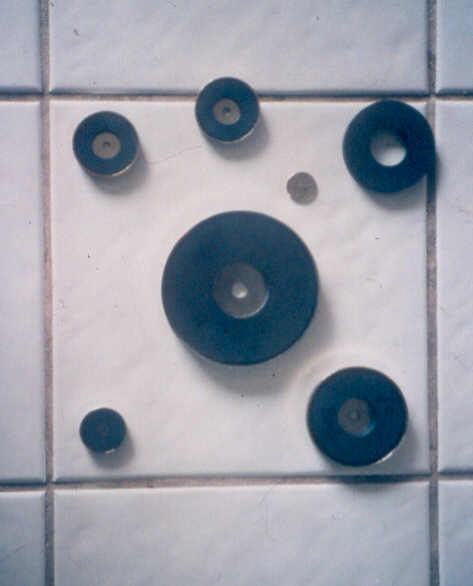
Compared to pulsed electromagnetic fields,
ferrite-ring magnets represent a low-tech approach that may restore some
function after spinal cord injury (SCI) and dysfunction.
Ferrite-ring magnets (shown in photo next to quarter)
create a relatively powerful, toroidal spinning field, which in shape
resembles the earth’s magnetic field. Such a field more readily resonates
with nature and living things.
In a simple, yet visual, demonstration of field
strength, a five-inch ring magnet is able to alter a television image from
nearly two feet away. Clearly, th ese
magnets have the potential to influence organs and physiology deep beneath
the body’s surface.
ese
magnets have the potential to influence organs and physiology deep beneath
the body’s surface.
Because many commercially available products use
relatively weak magnets, their effectiveness is questionable. For example,
the magnets in many mattress pads are so weak that little field extends
beyond the intervening padding, sheets, and pajamas.
The powerful ferrite-ring magnets are inserted into
various clothing or devices that place the magnets as close as possible to
specific body areas. For example in SCI, one could wear a
magnet-containing vest (or drape it over the wheelchair back), sit over a
magnet located under the wheelchair’s seat cushion, and sleep on a
mattress pad containing the ring magnets.
Example Cases
Lee, 29, was paralyzed in a construction
accident. After a spinal cord blood vessel burst, he progressively lost
function, including bowel-and-bladder control and sexual ability, and
could only walk a limited distance using a walker. Five months after
injury, Lee started treatment with the ring magnets and obtained
remarkable results. After a half year of therapy, Lee regained most of his
lost function. Although I did not personally talk to Lee, a physician
independently confirmed his recovery.
I did, however, talk to Art and Grace. Art
became a C5-6 quadriplegic in a 1981 car accident. His case represents an
example of the more subtle improvement that may result from magnetic
therapy many years after injury.
A sports writer who recently obtained his Master’s
degree in rehabilitation counseling, Art has used ring magnets for four
years and believes that he has accrued subtle, but significant, benefits
from them. He feels stronger, especially in the trunk region, has new
tingling sensations that seem to grow with time, and sweats more than he
has since his injury nearly 20 years ago. Furthermore, MRI imaging now
indicates a much more viable spinal cord.
Grace, who has spina bifida (a neural tube birth
defect in which a portion of the spinal cord protrudes through the
vertebral column), had been plagued with recurring pressure soars. When
her last sore would not heal, she tried the magnets. Because it was the
first soar that healed without surgery, she is now a believer.
What further amazed Grace were some other
improvements that seemed to be correlated with her magnetic therapy.
Specifically, she could contract her left gluteal and thigh muscles for
the first time, which, she believes, is indicative of some nerve healing.
In addition, her left leg got longer with new bone growth as documented by
x-rays.
Conclusion
Because these represent a limited number of anecdotal
cases with unique circumstances, we must be careful in extrapolating the
results. Although dramatic results are probably the exception, subtle
improvements that can significantly affect quality of life and
independence may be a real possibility with perseverance.
This article is based on the work of Richard Hopkins,
a magnetic therapist who died in 2000.
Sources: With some research, including the
Internet, ferrite-ring magnets can be obtained from numerous sources. They
can also be obtained from Richard Hopkins' son Jon (email:
hopkinshands@yahoo.com).